UC10
Price/CO2 based optimization
1. Description of the Use Case
1.1. Name of the Use Case
| ID | Area /Domain(s)/Zone(s) | Name of the Use Case |
|---|
| 1 | / Customer premises / Process, Field, Station, Operation, Enterprises, Market, | UC10 |
1.2. Version Management
| Version No. | Date | Name of author(s) | Changes | Approval status |
|---|
| V1 | 2020-09-25T00:00:00 | DTU, | First Draft | None |
1.3. Scope and Objectives of Use Case
| |
|---|
| Scope | This use case is aimed at unlocking the energy flexibility potential of end-users using smart energy management system, i.e. price-based or CO2-based optimal control, to enabling their participation in demand-response programs. |
| Objective(s) | 1. Reduce building energy bills and CO2 emissions |
| 2. Enable an automatic load response to price signals (price-based demand response programs) | |
| 3. Enhance the control strategy of power-to-heat technologies coupled with thermal storage to increase building flexibility | |
| 4. Develop forecasting algorithms to better exploit building flexibility | |
| Related business case(s) | Associate with UC7 |
1.4. Narrative of Use Case
Short description
Price/CO2-based control is an indirect control mechanism that can be used to drive end-users’ power consumption on the basis of signals representative of market or grid (e.g., TSO/DSO) requirements. Indeed, end-users linked to time-varying electricity or network tariffs and equipped with smart controllers can react to changes in the price of electricity over time by shifting their consumption from peak to low-tariff hours, thus reducing their energy costs on the one hand and the overall demand, during peak-hours, on the other.
Complete description
Demand response (DR) is a promising way to exploit end users’ flexibility for supporting grid balancing and management. Among DR programs, price-based programs (also known as implicit DR programs) are recognized as the most suited for engaging low-voltage end-users, like households, in grid operations. Indeed, utilities equipped with controllers capable to react to external signals, like time-varying electricity prices, can exploit storage capacities (e.g.e.g., water of swimming pools) to implement load-shifting strategies that, on the one hand, reduce their energy cost and, on the other end, provide a service to the grid (e.g., peak-shaving, congestion relief, etc.). The present use case is structured as follows:
(1) Each day, the market operators upload the market clearing prices (spot prices) for the next 24 hours to the Cloud platform, where they will be accessible to all the authorized end-users.
(2) X hours before Real-Time Operations (RTO), the Control Management Unit (CMU) acquires the electricity tariffs from a Cloud platform (Internet service), and previously to RTO the CMU acquires all the information (e.g., sensors data, weather forecasting, etc.) needed to optimize the end-user energy consumption over the considered control horizon (e.g. 24 hours).
(3) The CMU optimize the end-user’s consumption on the basis of the data gathered and implement the optimal control action.
| ID | Name | Description | Reference to mentioned use case objectives |
|---|
| KPI_1 | Operational cost-saving (%) | Energy cost reduction by participating in price-based demand response programs (e.g., €/day) | 1, |
1.6. Use case conditions
| Relation to other use cases |
|---|
|
| Level of depth |
| Prioritisation |
| Mandatory |
| Generic, regional or national relation |
| Generic |
| Nature of the use cases |
| Technical |
| Further keywords for classification |
| Demand Response, Distribution Network Operation, Aggregator, Energy Flexibility |
2. Diagrams of Use Case
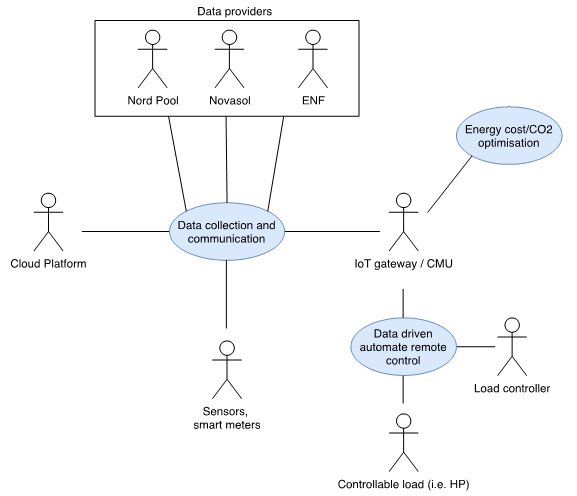
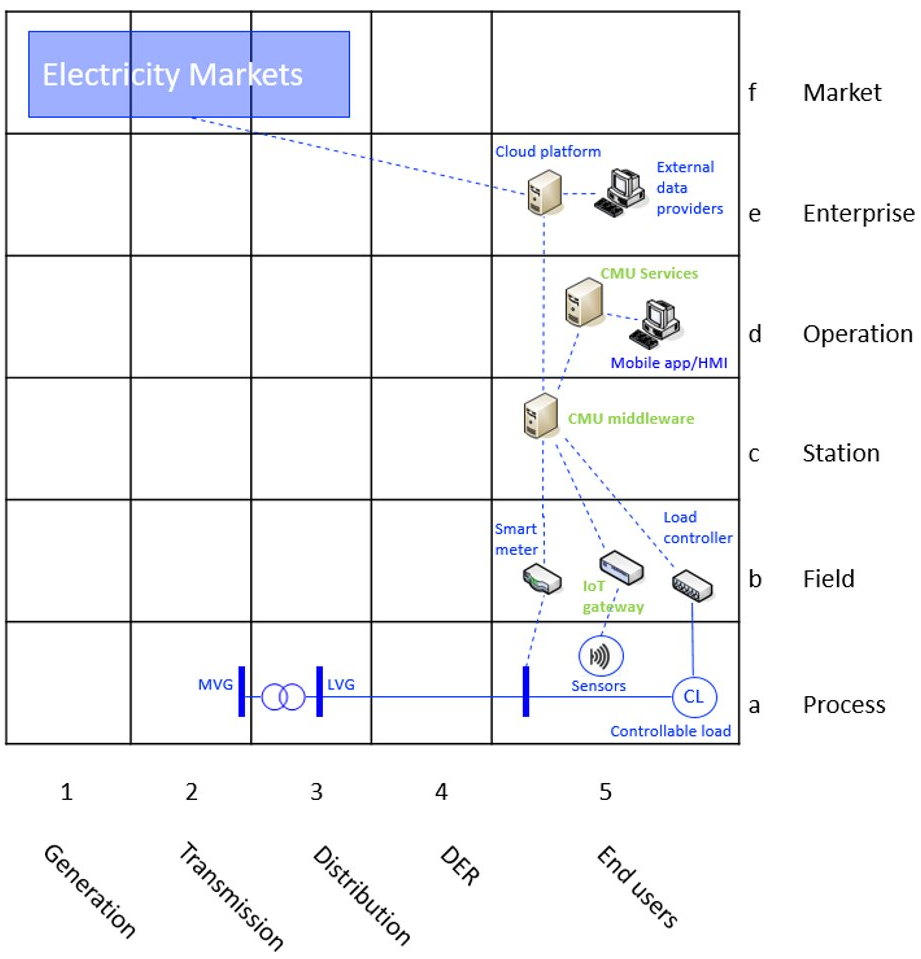
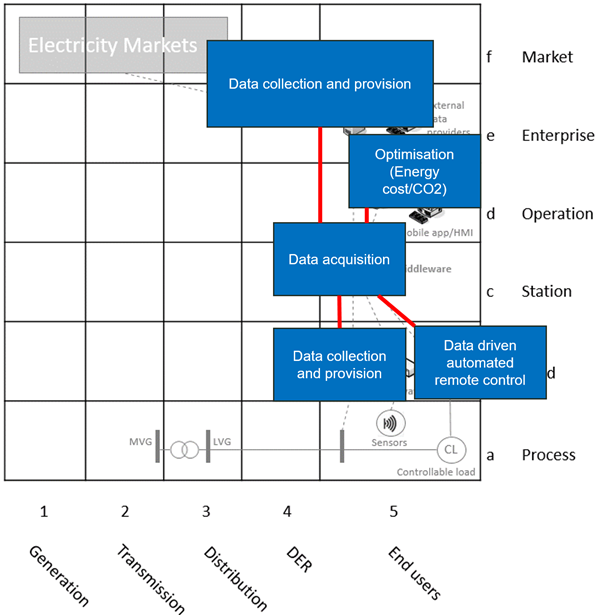
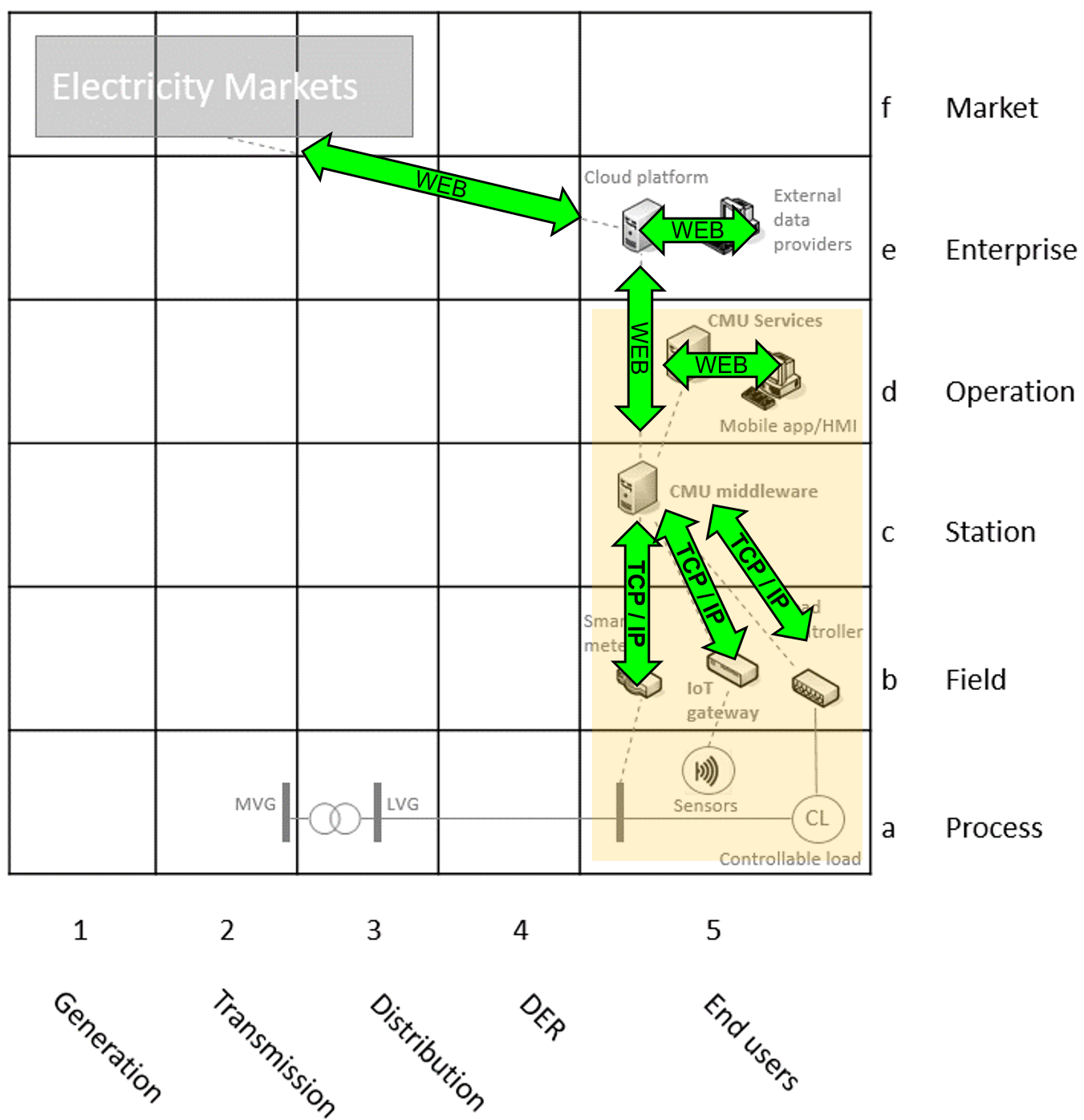
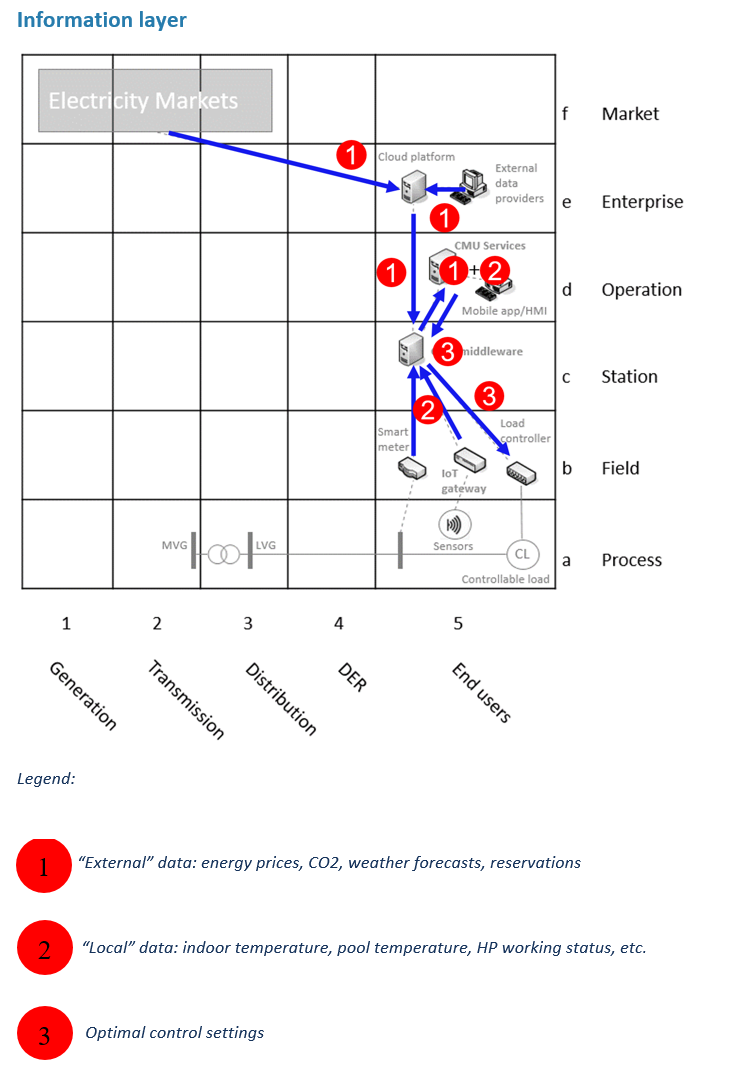

3. Technical Details
3.1. Actors
| Actor Name | Actor Type | Actor Description | Further information specific to this Use Case |
|---|
| Sensors, Smart meters | System | Gather data at building level (e.g. indoor temperature and humidity, HP power consumption, water pool temperature) and broadcast them to the Control Management Unit through the IoT Gateway. | |
| Controllable loads | System | Controllable devices within a building, which consume electricity, such as heat pumps, electric boilers, ventilation systems, dishwashers, fridges, freezers, dryers etc. | |
| IoT gateway | System | IoT Gateway to integrate multi-vendor devices with processing capability (embedded Raspberry-Pi). | |
| Cloud Platform | System | A cloud and web-based software platform which provides data-driven energy performance reporting, alarm, and notification system, compatible with all devices and systems such as smart meters, energy analyzers, automation systems and 3rd party software, providing an intuitive user interface for building and district level stakeholders. | |
| Customer Management Unit (CMU) | System | Application that optimize the operation of the controllable loads on the basis of price/CO2 forecasts. | |
| Load controller | System | Unit deployed at building level to control IoT devices and loads (e.g. Heat Pump). | |
3.2. References
| No. | References Type | Reference | Status | Impact on Use Case | Organistaor / Organisation | Link |
|---|
4. Step by Step Analysis of Use Case
4.1. Overview of Scenarios
| No. | Scenario Name | Scenario Description | Primary Actor | Triggering Event | Pre-Condition | Post-Condition |
|---|
| PS1 | Energy cost/CO2 optimization | The energy balancing/flexibility platform sends to every CMU/IoT gateway prices and forecasting and they perform the CO2/Cost optimization. | | Energy cost/CO2 optimization | | |
| AS1 | End users preference prioritization | The CMU selects a non-optimal operation given the users preferences. | | End users preference prioritization | | |
Notes
4.2. Steps – Scenarios
| Scenario Name: |
|---|
| Energy cost/CO2 optimization |
| Step No. | Event. | Name of Process/ Activity | Description of Process/ Activity. | Service | Information Producer (Actor) | Information Receiver (Actor) | Information Exchanged | Requirements, R-ID |
|---|
| 1 | 11-15 min | None | Sensors and Smart meters broadcast data to the IoT gateway. | GET | | | | |
| 2 | hourly | None | The Cloud Platform acquires market data (e.g. energy prices, CO2), complement it with additional information (e.g. weather forecasting, booking status of summer houses), and make them available to the CMU. | GET | | | | |
| 3 | hourly | None | IoT gateway gathers data from the Cloud. | GET | | | | |
| 4 | hourly | None | IoT gateway transmits data gathered to the Control Management Unit. | GET | | | | |
| 5 | Data (prices, weather forecasting, booking status) acquired | None | The Customer Management Unit defines the optimal control strategy to unlock the energy flexibility potential of the end users. | CREATE | | | | |
| 6 | Optimization problem solved | None | The Control Management Unit broadcasts the optimal control signals (i.e. setpoints) to the Load Controller. | GET | | | | |
| 7 | Optimal setpoints received | None | The load controller reformats the setpoints, or operating status, of the controllable devices, and broadcasts the new values to the controlled loads. | GET | | | | |
| 8 | Optimal setpoints received | None | Controllable devices update their operation parameters according to the new optimal setpoints. | EXECUTE | | | | |
| Scenario Name: |
|---|
| End users preference prioritization |
| Step No. | Event. | Name of Process/ Activity | Description of Process/ Activity. | Service | Information Producer (Actor) | Information Receiver (Actor) | Information Exchanged | Requirements, R-ID |
|---|
| 1 | Customer setpoints received | None | The customers reformat the setpoints of the controllable devices | GET | | | | |
| 2 | Customer setpoints received | None | Controllable devices update their operation parameters according to the new setpoints. | EXECUTE | | | | |
| Information exchanged ID | Name of Information | Description of Information Exchanged | Requirement |
|---|
6. Requirements (optional)
| Category Identifier | Name | Description | mRID |
|---|
| Req_ID | Req_Name | ‘Price/CO2 based optimization’ | |
| Identifier | Name | Description | mRID |
|---|
| 1 | Sensor and Smart meter measurements | Air temperature and humidity, pool water temperature, electric consumption. | Privacy |
| 2 | Price/ CO2 data | Market data: electricity prices and CO2 emission factor | 2 |
| 3 | Weather forecast | Weather forecasting | Availability of data |
| 4 | Convenience | Additional parameters that affect the optimal control problem (i.e., occupants’ comfort requirements). | Availability of data |
| 5 | Optimal control strategy | Outputs of the optimal control problem solved to unlock the energy flexibility potential of end users. | 5 |
| 6 | Optimal setpoints | Steering signals used to control/modify the operational status of the controllable devices. | 6 |
| 7 | Operation parameters | Parameters identifying the operational status of the controlled devices (e.g., on/off) | 7 |
7. Common Terms and Definitions
| Key | Value | Refers to Section |
|---|





